Ja falei para vocês que eu adoro imagens antigas. Principalmente se feitas somente pelo punho humano (sem a utilização da computação). As imagens dão um sentimento nostálgico, uma sensação de que o povo era desbravador, buscava mais o conhecimento. É só pegar livros de Cirurgia antigos e novos e comparar. (Lógico que as imagens e metodologia dos novos são melhores mas nada comparada a linguagem dos antigos.)
Achei um site sobre traumatologia com um capítulo dedicado ao trauma facial, posto aqui. Não é de autoria minha e está no idioma inglês… enjoy!
The general method for maxillofacial injuries
(extraído de http://www.primary-surgery.org/ps/vol2/html/sect0181.html)
A patient with a severe facial injury is a very distressing sight—so distressing that you may feel that you can do nothing for him. In fact, you can do much, and maxillofacial injuries are no more difficult (or easy) than any others. They are usually the result of road accidents, and seat belts prevent most of them.
Not suprisingly, the parts of the face which stick out are those which are most often injured—a patient’s nose, his zygoma, or his mandible. Fortunately, their injuries are usually not too difficult to treat. Much greater force has to be applied to fracture his maxilla, with the result that maxillary injuries are less common, but much more difficult. Although we describe each injury separately here, a patient is likely to have several of them, and other injuries also, especially injuries to his head and eyes.
Fractures of the middle third of the face are so complex that we shall not attempt to classify them except to say that the usual classification is that of Le Fort, who divided them into Types One, Two, and Three, as shown in Fig. 62-1. In a Type One fracture the alveolus, or tooth bearing part of the patient’s upper jaw, breaks off, and may drop onto his lower teeth. In Types Two and Three the fracture lines are higher up in his maxilla. These fracture types may be combined, and may occur on one or both sides. The radiology, reduction, and fixation of the more difficult Le Fort fractures is beyond a district hospital. But prompt treatment, particularly in securing a patient’s airway, may save his life, after which you have several days in which to refer him for expert reduction and fixation. Failure to reduce one of these fractures can cause severe deformities, which include a jaw which does not close, ’dish face’, and diplopia. If you cannot refer a patient, we describe some of the easier methods you can use.
WHAT OTHER INJURIES DOES THE PATIENT HAVE?
The critical displacement in Le Fort fractures of Types Two and Three is the downward movement of the bones of the middle of the patient’s face, as shown in Fig. 62-2. The strong front of his cranium forms an inclined plane, down which his facial skeleton slides. (1) This lengthens his face. (2) It pushes his upper molars down onto his lower ones so that they gag (prevent his jaw closing properly). (3) It pushes his soft palate down onto his tongue and prevents him breathing through this mouth. At the same time, his fracture bleeds severely, and his nose is obstructed by blood clot. The result is that he may suffocate, so the immediate life saving procedure is to hook two of your fingers round the back of is hard palate, and pull his maxilla back up the inclined plane of his skull. This will allow him to breathe. His breathing can also be obstructed by bilateral fractures of his lower jaw which allow his tongue to fall back against his pharynx.
Figure 62.1: FRACTURES OF THE MIDDLE THIRD OF THE FACE. In a Type One fracture the alveolus, or tooth bearing part of the patient’s upper jaw, breaks off, and may drop onto his lower teeth. In Types Two and Three the bones of the middle of the patient’s face slide downwards, as shown in the next figure. These fracture types may be combined and may occur on one or both sides.
Fractures of the middle third of a patient’s face have several other unfortunate features: (1) They are always multiple, sometimes with 50 or more fragments. (2) Several of his cranial nerves may be injured, especially his infraorbital and superior dental nerves. (3) His ethmoid may be fractured and his dura torn, so that CSF leaks from his nose. (4) His orbit may be fractured (Fig. 62-3), sometimes with the displacement of its contents into his maxillary sinuses (the orbital blow-out syndrome). (5) The circulation to his eye may be obstructed and make him blind if the obstruction is not relieved within minutes of the accident (the ophthalmic canal syndrome). (6) His maxillary sinuses may fill with blood. (7) His nasolachrymal ducts may be injured and cause a flow of tears.
When you treat such a patient aim to: (1) Restore his airway. (2) Control bleeding. (3) Make his teeth bite normally. You should be able to do this with most fractures of his mandible, and some fractures of his maxilla. If either his maxilla or his mandible is intact, you can use one of them to splint the other. If you can make his bite normal, reduction will be perfect. (4) Prevent some deformities by reducing fractures of his nose and zygoma.
Figure 62.2: DOWNWARD DISPLACEMENT OF THE MAXILLA. A, if the patient’s respiration is obstructed, push a nasopharyngeal airway down one or both sides of his nose. B, C, and D, show how the front of his skull forms an inclined plane down which his maxilla can be pushed. After Killey, with kind permission.
If you can refer a patient, do so early because the longer you wait, the more difficult reduction will become. If you cannot refer him, you can certainly save his life, but he may have to live with his deformities. Soon after the injury his face will look distressingly swollen, so do your best to reassure him and his family. The face has a good blood supply and will heal well, so that they can expect him to improve remarkably. But it can also swell quickly and hide underlying deformities, so examine him with care when you first see him.
Figure 62.3: THE ORBITAL BLOW-OUT SYNDROME. A, a blow to the patient’s orbit has broken its floor, so that its contents have prolapsed into his antrum. B, unless you refer him to have it repaired, he may have permanent enophthalmos, diplopia and loss of upward eye movement. From Rutherford, Nelson, Weston and Wilson with kind permission.
The methods we describe assume you don’t have a dental laboratory, and so cannot make cap splints, etc. You will however need a drill and some soft stainless steel wire (70.9). Occasionally an arch bar is useful. If you can get the help of a dentist, always do so.
•ARCH BAR, stainless steel, five only. Sometimes, the most convenient way to fix the fragments of a patient’s upper or lower jaw is to bend a metal bar, to shape it, and to wire it to his teeth. If you don’t have a proper arch bar, you can use any tough piece of stainless steel wire, or even some paper clips twisted together.
A SWOLLEN FACE CAN CONCEAL A MAJOR INJURY
Clique aqui para continuar – veja o site original
Abaixo algumas imagens antigas que não são mais encontradas nos livros atuais…
Olhem que fantástico a imagem do acesso de Gillies…
Imagem de Avaliação para deslocamentos do zigoma (vou começar a utilizar esse método)
Nenhum livro atual demonstra estas particularidades, o conhecimento destes “macetes” estão sendo passados atualmente somente por via oral, por isso gosto dos livros antigos.

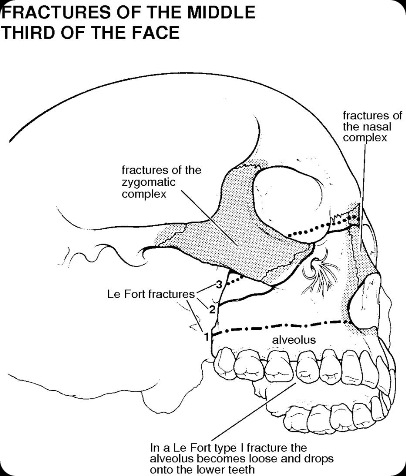
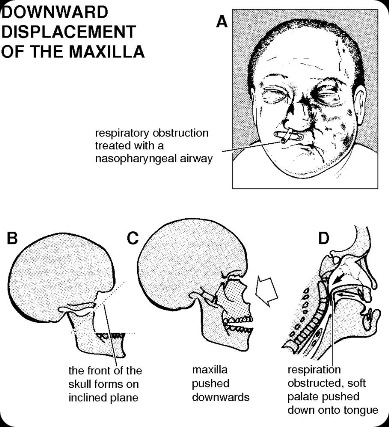
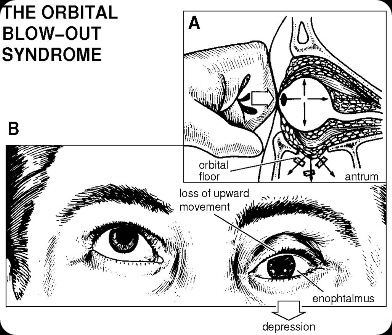
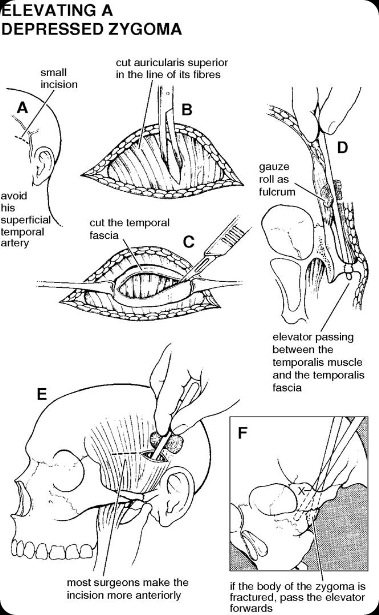
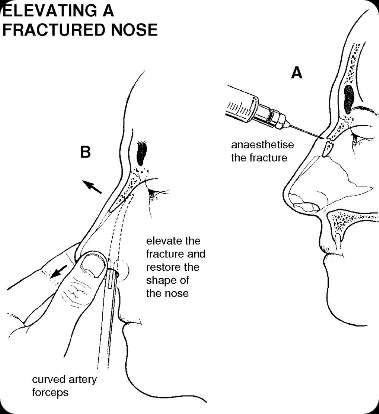
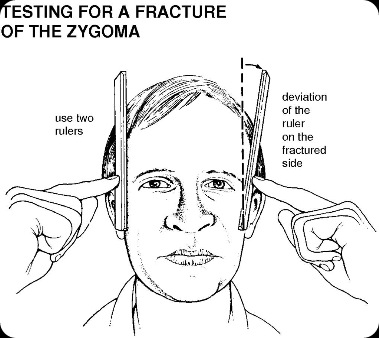
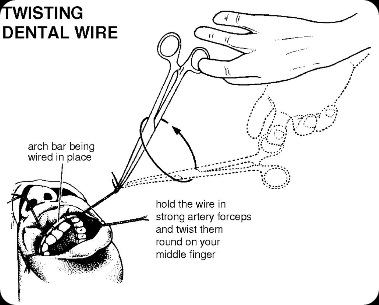
Dr. Mario, o senhor está corretissimo!!Meu pai é Cbmf, e possui varios livros "velhos" e eu sempre dei uma olhada apesar de estar no 3º de Odonto, mas ficava com medo de estudar tecnicas muito ultrapassadas e decorar nomes alterados. Na ultima Ciops acabei adiquirindo o livro "Principios de Cirurgia BMF", do Perteson akele novo de 2 volumes, estou achando o livro muito bom, mas ele não oferece esse "macetes" q são apresentados visualmente.
ResponderExcluirParabens pelo blog, creio que ele ajuda a mostrar a importacia e o prestigio do C.D.
Dr. Mario concordo plenamente c vc qt aos livros antigos! estou no 8° periodo d odonto e pretendo fazer resodencia em CTBMF e por issu tenhu estudado bastante, mas um dos livros q eu mais gosto eh o Dingmam, que eh antigo mas ensina varias tecnicas e massetes cirurgicos.
ResponderExcluirahhh Adooooroooo seu blog e sempre entro p ver as noviddaes. Parabéns pelo empenho!